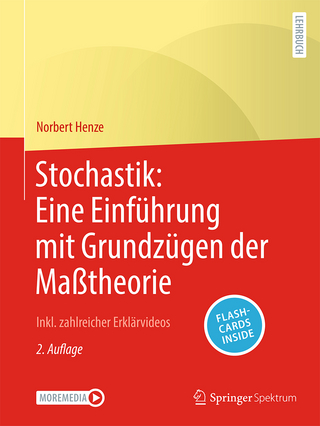
New Theory of Discriminant Analysis After R. Fisher
Springer Verlag, Singapore
978-981-10-9546-7 (ISBN)
We compared two statistical LDFs and six MP-based LDFs. Those were Fisher’s LDF, logistic regression, three SVMs, Revised IP-OLDF, and another two OLDFs. Only a hard-margin SVM (H-SVM) and Revised IP-OLDF could discriminate LSD theoretically (Problem 2). We solved the defect of the generalized inverse matrices (Problem 3).
For more than 10 years, many researchers have struggled to analyze the microarray dataset that is LSD (Problem 5). If we call the linearly separable model "Matroska," the dataset consists of numerous smaller Matroskas in it. We develop the Matroska feature selection method (Method 2). It finds the surprising structure of the dataset that is the disjoint union of several small Matroskas. Our theory and methods reveal new facts of gene analysis.
Shuichi Shinmura, Seikei University
1 New Theory of Discriminant Analysis.- 1.1 Introduction.- 1.2 Motivation for our Research.- 1.3 Discriminant Functions.- 1.4 Unresolved Problem (Problem 1).- 1.5 LSD Discrimination (Problem 2).- 1.6 Generalized Inverse Matrices (Problem 3).- 1.7 K-fold Cross-validation (Problem 4).- 1.8 Matroska Feature Selection Method (Problem 5) .- 1.9 Summary.- References.- 2 Iris Data and Fisher’s Assumption.- 2.1 Introduction.- 2.2 Iris Data.- 2.3 Comparison of Seven LDFs.- 2.4 100-folf Cross-validation for Small Sample Method (Method 1).- 2.5 Summary.- References.- 3 The Cephalo-Pelvic Disproportion (CPD) Data with Collinearity.- 3.1 Introduction.- 3.2 CPD Data.- 3.3 100-folf Cross-validation.- 3.4 Trial to Remove Collinearity.- 3.5 Summary.- References.- 4 Student Data and Problem 1.- 4.1 Introduction.- 4.2 Student Data.- 4.3 100-folf Cross-validation for Student Data.- 4.4 Student Linearly Separable Data.- 4.5 Summary.- References.- 5 The Pass/Fail Determination using Exam Scores -A Trivial Linear Discriminant Function.- 5.1 Introduction.- 5.2 Pass/Fail Determination by Exam Scores Data in 2012.- 5.3 Pass/Fail Determination by Exam Scores (50% Level in 2012).- 5.4 Pass/Fail Determination by Exam Scores (90% Level in 2012).- 5.5 Pass/Fail Determination by Exam Scores (10% Level in 2012).- 5.6 Summary.- 6 Best Model for the Swiss Banknote Data – Explanation 1 of Matroska Feature -selection Method (Method 2) -. References.- 6 Best Model for Swiss Banknote Data.- 6.1 Introduction.- 6.2 Swiss Banknote Data.- 6.3 100-folf Cross-validation for Small Sample Method.- 6.4 Explanation 1 for Swiss Banknote Data.- 6.5 Summary.- References.- 7 Japanese Automobile Data – Explanation 2 of Matroska Feature Selection Method (Method 2).- 7.1 Introduction.- 7.2 Japanese Automobile Data.- 7.3 100-folf Cross-validation (Method 1).- 7.4 Matroska Feature Selection Method (Method 2).- 7.5 Summary.- References.- 8 Matroska Feature Selection Method for Microarray Data (Method 2).- 8.1 Introduction.-8.2 Matroska Feature Selection Method (Method2).- 8.3 Results of the Golub et al. Dataset.- 8.4 How to Analyze the First BGS.- 8.5 Statistical Analysis of SM1.- 8.6 Summary.- References.- 9 LINGO Program 1 of Method 1.- 9.1 Introduction.- 9.2 Natural (Mathematical) Notation by LINGO.- 9.3 Iris Data in Excel.- 9.4 Six LDFs by LINGO.- 9.5 Discrimination of Iris Data by LINGO.- 9.6 How to Generate Re-sampling Samples and Prepare Data in Excel File.- 9.7 Set Model by LINGO.- Index.
| Erscheinungsdatum | 18.08.2018 |
|---|---|
| Zusatzinfo | 25 Illustrations, color; 3 Illustrations, black and white; XX, 208 p. 28 illus., 25 illus. in color. |
| Verlagsort | Singapore |
| Sprache | englisch |
| Maße | 155 x 235 mm |
| Themenwelt | Mathematik / Informatik ► Mathematik ► Wahrscheinlichkeit / Kombinatorik |
| Naturwissenschaften ► Biologie | |
| Sozialwissenschaften ► Soziologie ► Empirische Sozialforschung | |
| Schlagworte | 100-fold Cross Validation for Small Sample Method • Comparison of Eight LDFs • Matroska Feature Selection Method for Microarray Data • Model Selection by Best Model • Simple Structure of Microarray Data |
| ISBN-10 | 981-10-9546-9 / 9811095469 |
| ISBN-13 | 978-981-10-9546-7 / 9789811095467 |
| Zustand | Neuware |
| Informationen gemäß Produktsicherheitsverordnung (GPSR) | |
| Haben Sie eine Frage zum Produkt? |
aus dem Bereich


